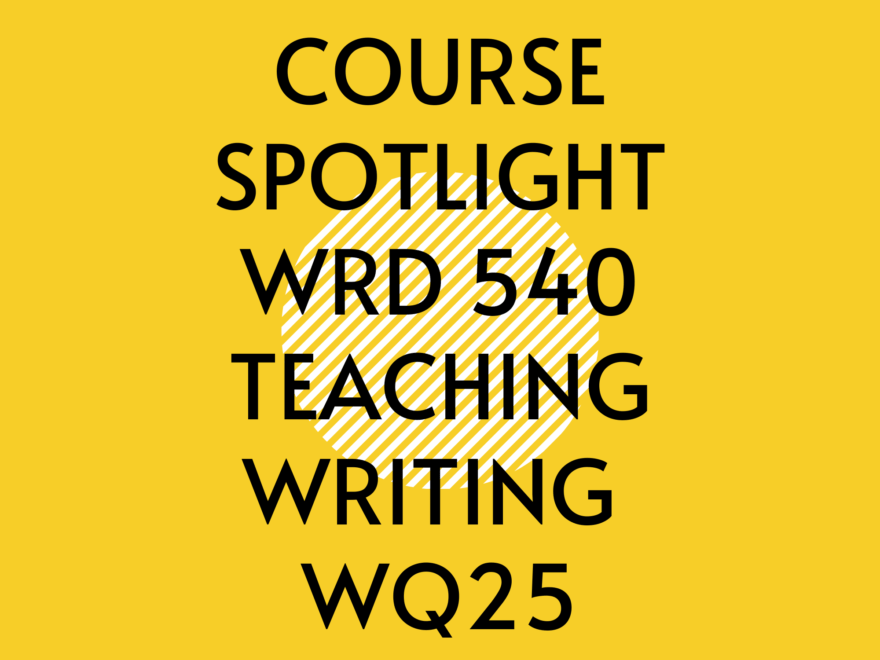WRD 540 Teaching Writing is a great introduction to those interested in teaching writing after they graduate, it’s in the name! This class gives students tools to understand different methodologies for teaching composition and looks at modern theories of rhetoric, reading, and language acquisition. Dr. Erin Workman has been teaching this course for the last few years and here she provides a new perspective on the course that will be offered this Winter Quarter 2025.
Are there any differences since the last spotlight last Fall?
Everything covered in last year’s spotlight is still relevant, including the hybrid modality with weeks 1, 2, and 4-6 on campus and weeks 3 and 7-10 on Zoom.
What do you think is important for students to know who are excited by the idea but nervous about teaching?
For students who are excited by the idea but nervous about teaching, WRD 540 is a good introductory course offering the opportunity to develop conceptual knowledge about writing and approaches to teaching writing without the anxiety of teaching a writing course. In 540 we engage various approaches to teaching writing, reviewing historical and conceptual scholarship on writing instruction, exploring theories of composition and the pedagogical practices promoted by each, including axiology, views of process and pedagogy, and epistemological underpinnings. In doing so, we consider our individual and disciplinary conceptions of writing, learn about writing development and the incomes students bring to writing classes, explore research on writing processes and practices, and try out various approaches to writing response and assessment, assignment development, and course design.
Students in 540 have opportunities to practice some of the challenging components of teaching writing—such as facilitating discussions and activities, responding to and assessing student writing, and designing productive assignments and activities—in a supportive community where they can practice and get immediate feedback on their performance. Students also observe one or more writing classes in action, another low stakes opportunity for seeing what teaching can look like without the pressure of being the teacher. If you’re nervous or unsure about teaching, 540 will help you better understand what teaching entails; if you enjoy the course, you can then apply for TAP or the TETYC internship to get practical experience as instructor of record or as an intern.
Does this class also strengthen students’ own writing? In what way?
Yes, I believe so, and I’ve had students confirm this in OTEs (Online Teaching Evaluations) as well. For the first half of the course, we focus on articulating and further developing our individual conceptions of writing, writing processes, and writing practices, and reflecting on the literate experiences shaping our perceptions and approaches. By engaging in scaffolded writing activities and assignments, students systematically explore what writing means to them—a process that helps them articulate what is otherwise tacit—and how they actually do it; this, alongside learning more about how writers and writing develops, what other processes and practices exist, how writing technologies and tools enable and constrain practice, and much more, helps students approach their writing more intentionally and creatively. Students have commented that some of the negative perceptions they had of their writing processes and themselves as writers dissipated through the course, beginning with their literacy narrative and accompanying process documentation.
Is there anything else that you think is important for students to know who may be interested in taking WRD 540 this Winter Quarter?
Much of our focus is theoretical and conceptual; while we discuss application and engage in some practice with responding to and assessing student work, observing other
instructors, and facilitating discussion/activity among ourselves, issues of practice are taken up more directly in WRD 551 Teaching Apprenticeship Practicum. Although we will discuss writing capaciously as an activity, we will approach it as a subject of study through the discipline of writing studies. Many of the concepts and scholarship may be new, and that experience can feel daunting, but we each bring a perspective that is valuable to share and discuss within our classroom community.
Conclusion
This course is a great way to understand teaching theory and methodology. It gives students the confidence they need to continue their education and eventually enter the world of teaching. For perspectives from students themselves, check out our course recap from this past spring.
